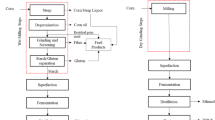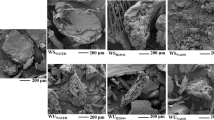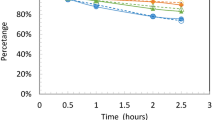Abstract
Dried distillers grains with solubles (DDGS), a co-product of corn ethanol production in the dry-grind process, was pretreated by soaking in aqueous ammonia (SAA) using a 15 % w/w NH4OH solution at a solid/liquid ratio of 1:10. The effect of pretreatment on subsequent enzymatic hydrolysis was studied at two temperatures (40 and 60 °C) and four reaction times (6, 12, 24, and 48 h). Highest glucose yield of 91 % theoretical was obtained for the DDGS pretreated at 60 °C and 24 h. The solubilized hemicellulose in the liquid fraction was further hydrolyzed with dilute H2SO4 to generate fermentable monomeric sugars. The conditions of acid hydrolysis included 1 and 4 wt% acid, 60 and 120 °C, and 0.5 and 1 h. Highest yields of xylose and arabinose were obtained at 4 wt% acid, 120 °C, and 1 h. The fermentability of the hydrolysate obtained by enzymatic hydrolysis of the SAA-pretreated DDGS was demonstrated in ethanol fermentation by Saccharomyces cerevisiae. The fermentability of the hydrolysate obtained by consecutive enzymatic and dilute acid hydrolysis was demonstrated using a succinic acid-producing microorganism, strain Escherichia coli AFP184. Under the fermentation conditions, complete utilization of glucose and arabinose was observed, whereas only 47 % of xylose was used. The succinic acid yield was 0.60 g/g total sugar consumed.





Similar content being viewed by others
References
OECD/FAO (2012), OECD-FAO Agricultural outlook 2012–2021, OECD Publishing and FAO. http://dx.doi.org/10.1787/agr_outlook-2012-en
Ethanol industry outlook. (2015). Renewable Fuels Association, Washington DC.
Kim, Y., Hendrickson, R., Mosier, N. S., Ladisch, M. R., Bals, B., Balan, V., & Dale, B. E. (2008). Enzyme hydrolysis and ethanol fermentation of liquid hot water and AFEX pretreated distillers’ grains at high-solids loadings. Bioresource Technology, 99, 5206–5215.
Dien, B. S., Ximenes, E. A., O’Bryan, P. J., Moniruzzaman, M., Li, X. L., Balan, V., Dale, B. E., & Cotta, M. A. (2008). Enzyme characterization for hydrolysis of AFEX and liquid hot-water pretreated distillers’ grains and their conversion to ethanol. Bioresource Technology, 99, 5216–5225.
Kim, Y., Hendrickson, R., Mosier, N. S., Ladisch, M. R., Bals, B., Balan, V., Dale, B. E., Dien, B. S., & Cotta, M. A. (2010). Effect of compositional variability of distillers’ grains on cellulosic ethanol production. Bioresource Technology, 101, 5385–5393.
Ezeji, T., & Blaschek, H. P. (2008). Fermentation of dried distillers’ grains and solubles (DDGS) hydrolysates to solvents and value-added products by solventogenic clostridia. Bioresource Technology, 99, 5232–5242.
Wang, X., Wang, Y., Wang, B., Blaschek, H., Feng, H., & Li, Z. (2013). Biobutanol production from fiber-enhanced DDGS pretreated with electrolyzed water. Renewable Energy, 52, 16–22.
Ananda, N., & Vadlani, P. V. (2010). Fiber reduction and lipid enrichment in carotenoid-enriched distillers dried grain with solubles produced by secondary fermentation of Phaffia rhodozyma and Sporobolomyces roseus. Journal of Agricultural and Food Chemistry, 58, 12744–12748.
Romero, E., Bautista, J., Garcia-Martinez, A. M., Cremades, O., & Parrado, J. (2007). Bioconversion of corn distiller’s dried grains with solubles (CDDGS) to extracellular proteases and peptones. Process Biochemistry, 42, 1492–1497.
Xu, Y., Isom, L., & Hanna, M. A. (2010). Adding value to carbon dioxide from ethanol fermentations. Bioresource Technology, 101, 3311–3319.
Nghiem, N. P., Davison, B. H., Donnelly, M. I., Tsai, S.-P., & Frye, J. G. (2000). Chemicals and materials from renewable resources. In J. J. Bozell (Ed.), American Chemical Society Symposium Series, vol 784 (pp. 160–173).
Berglund, K. A., Dunuwila, D. D., & Alizadeh, H. (2003). U.S. Patent 6,623,657.
Berglund, K. A., Dunuwila, D. D., & Alizadeh, H. (2003). U.S. Patent 6,635,188.
Nghiem, N. P., Donnelly, M., & Millard, C. S. (1999). US Patent 5,869,301.
Donnelly, M., & Nghiem, N. P. (2004). U.S. Patent 6,743,610.
Kim, D. Y., Yim, S. C., Lee, P. C., Lee, W. G., Lee, S. Y., & Chang, H. N. (2004). Batch and continuous fermentation of succinic acid from wood hydrolysate by Mannheimia succiniciproducens MBEL55E. Enzyme and Microbial Technology, 35, 648–653.
Zhou, X., & Zheng, P. (2013). Spirit-based distillers’ grain as a promising raw material for succinic acid production. Biotechnology Letters, 35, 679–684.
Wang, B., Ezeji, T., Shi, Z., Feng, H., & Blaschek, H. P. (2009). Pretreatment and conversion of distiller’s dried grains with solubles for acetone- butanol-ethanol (ABE) production. Transaction of the ASABE, 52, 885–892.
Kim, T. H., Nghiem, N. P., & Hicks, K. B. (2009). Pretreatment and fractionation of corn stover by soaking in ethanol and aqueous ammonia. Applied Biochemistry and Biotechnology, 153, 171–179.
Nghiem, N. P., Montanti, M., Johnston, D. B., & Drapcho, C. (2011). Fractionation of corn fiber treated by soaking in aqueous ammonia (SAA) for isolation of hemicellulose B and production of C5 sugars by enzyme. Applied Biochemistry and Biotechnology, 164, 1390–1404.
Kim, T. H., Taylor, F., & Hicks, K. B. (2008). Bioethanol production from barley hull using SAA (soaking in aqueous ammonia) pretreatment. Bioresource Technology, 99, 5694–5702.
Nghiem, N. P., Kim, T. H., Yoo, C. G., & Hicks, K. B. (2013). Enzymatic fractionation of SAA-pretreated barley straw for production of fuel ethanol and astaxanthin as a value-added co-product. Applied Biochemistry and Biotechnology, 171, 341–351.
Zhang, X., & Nghiem, N. P. (2014). Pretreatment and fractionation of wheat straw for production of fuel ethanol and value-added co-products in a biorefinery. AIMS Bioengineering, 1, 40–52.
Nghiem, N. P., Nguyen, N. M., Drapcho, C. M., & Walker, T. H. (2013). Sweet sorghum biorefinery for production of fuel ethanol and value-added co-products. Biological Engineering Transactions, 6, 143–155.
Nghiem, N. P., Hicks, K. B., & Johnston, D. B. (2010). Integration of succinic acid and ethanol production with potential application in a corn or barley biorefinery. Applied Biochemistry and Biotechnology, 162, 1915–1928.
Sluiter, A., Hames, B., Ruiz, R., Scarlata, C., Sluiter, C., & Templeton, D. (2005). Determination of structural carbohydrates and lignin in biomass. Golden, CO.: National Renewable Energy Laboratory.
Nghiem, N. P., Montanti, J., & Johnston, D. B. (2009). Production of astaxanthin from corn fiber as a value-added co-product of fuel ethanol fermentation. Applied Biochemistry and Biotechnology, 154, 227–237.
Lau, M. W., Dale, B. E., & Balan, V. (2008). Ethanolic fermentation of hydrolysates from ammonia fiber expansion (AFEX) treated corn stover and distillers grains without detoxification and external nutrient supplementation. Biotechnology and Bioengineering, 99, 529–539.
Dien, B. S., Bothast, R. J., Nichols, N. N., & Cotta, M. A. (2002). The US corn ethanol industry: an overview of current technology and future prospects. International Sugar Journal, 104, 204–211.
Noureddini, H., & Byun, J. (2010). Dilute acid pretreatment of distillers’ grains and corn fiber. Bioresource Technology, 101, 1060–1067.
Acknowledgments
The authors would like to express their sincere thanks to Mr. Gerard Senske of the ERRC, who assisted in the experimental efforts and sample analysis, DuPont Industrial Biosciences for providing the enzyme products, Lincolnway Energy, LLC for providing the DDGS, and Mr. Kwang Ho Kim at the Department of Agricultural and Biosystems Engineering, Iowa State University for assisting in obtaining the DDGS. Tae Hyun Kim was supported by the R&D program of MOTIE/KETEP (No. 20153010091990).
Author information
Authors and Affiliations
Corresponding author
Additional information
Mention of trade names or commercial products in this article is solely for the purpose of providing specific information and does not imply recommendation or endorsement by the US Department of Agriculture (USDA). USDA is an equal employment provider and employer.
Rights and permissions
About this article
Cite this article
Nghiem, N.P., Montanti, J. & Kim, T.H. Pretreatment of Dried Distiller Grains with Solubles by Soaking in Aqueous Ammonia and Subsequent Enzymatic/Dilute Acid Hydrolysis to Produce Fermentable Sugars. Appl Biochem Biotechnol 179, 237–250 (2016). https://doi.org/10.1007/s12010-016-1990-2
Received:
Accepted:
Published:
Issue Date:
DOI: https://doi.org/10.1007/s12010-016-1990-2




